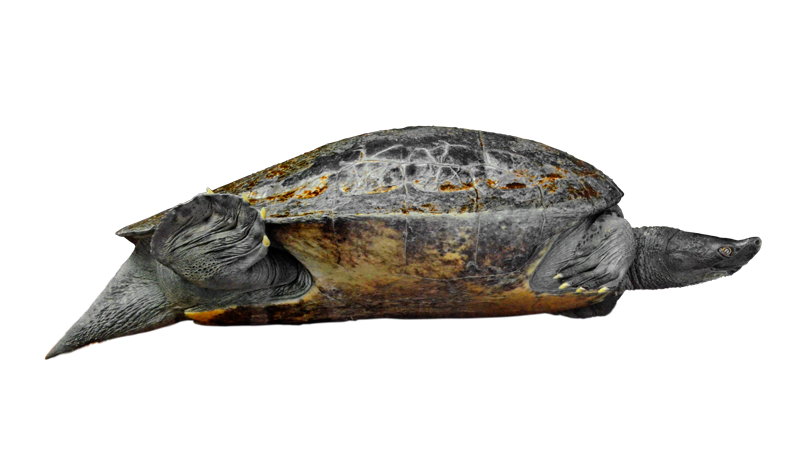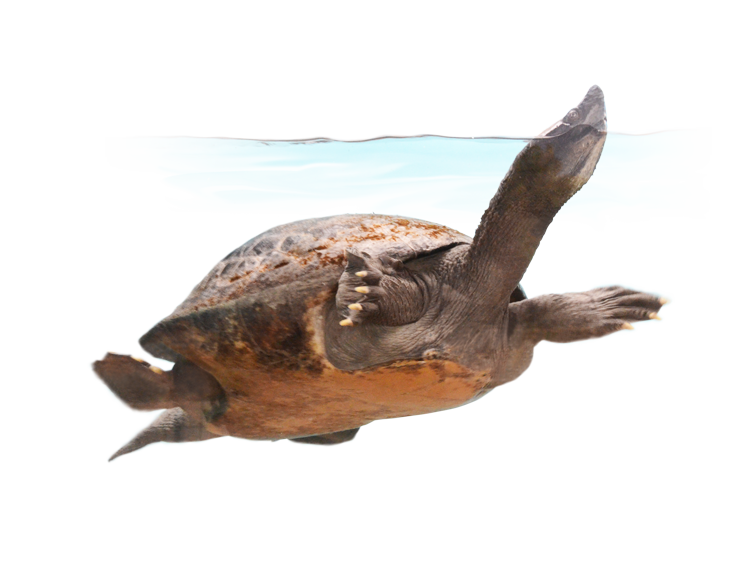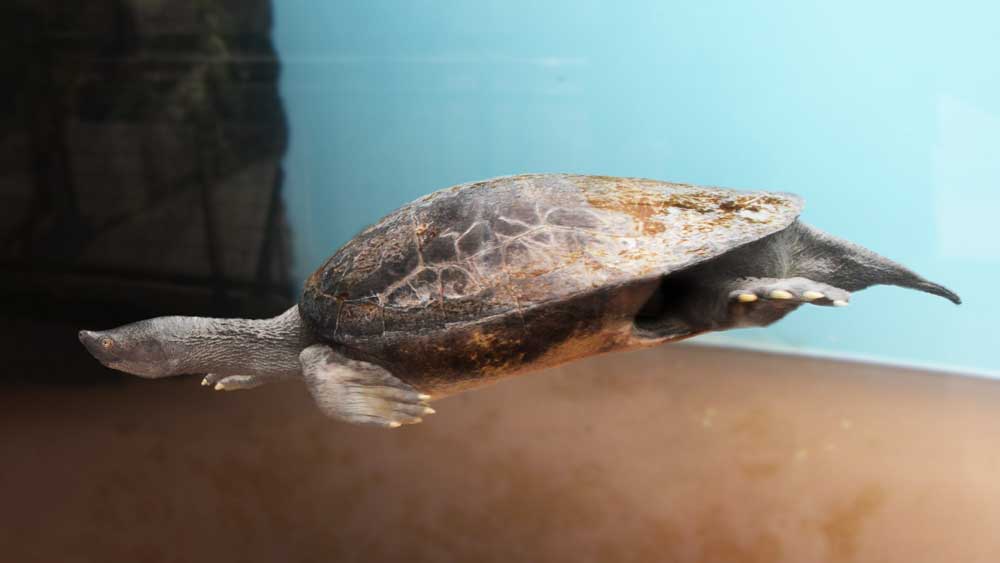
Butagur baska (Gray, 1831)
南北を隔てた巨大なイシガメ
The Giant River Terrapin Divided by North and South
成体の甲長は最大で約60cmに達し、アジアのイシガメ科に属する淡水性カメの中では最大級です。体重も重く、18kgほどに達する個体が確認されています。甲羅は成長とともに平坦になりますが、幼体では背甲中央に竜骨(キール)が見られることがあります。成体の背甲はオリーブ褐色から灰色を帯び、腹甲は黄味を帯びる傾向があります。繁殖期にはオスの頭部や首、四肢に鮮やかな赤や黒の婚姻色が現れます。
本種の分布はかつてインド、バングラデシュ、ミャンマーに及んでいましたが、現在では多くの地域で地域的絶滅が進行しています。特に、かつて多数が生息していたガンジス川流域やアユラワディ川デルタではほぼ絶滅状態とされ、野生個体数はごくわずかです。
よく似た近縁種の Southern river terrapin(Batagur affinis)は、タイ南部からマレーシア、スマトラ島に分布しており、かつては同一種とみなされていました。2001年の研究によると、ミトコンドリアDNA(mtDNA)解析と形態比較の結果、両者は約100万年前に分岐した姉妹種であることが明らかになっています。遺伝的距離は小さいものの、ベンガル湾を挟む長期的な地理的隔離によって、明確な系統分化が生じたと考えられます。
両種はいずれも世界で最も絶滅の危機に瀕したカメ類の一つであり、乱獲(卵・肉・ペット目的)や生息地の破壊、河川ダム建設などが深刻な脅威となっています。保全の取り組みの中で、飼育下繁殖に成功した例は限られていますが、2010年にはウィーン動物園で世界で初めてバタグールガメの繁殖に成功しました。また、バングラデシュでも人工ビーチや孵化場を設け、2010年代に複数回の孵化・育成に成功しており、育てた幼体を野外へ放流する試みが続けられています。

It breathes by exposing its extended nose to the surface of the water.
The adult carapace reaches up to about 60 cm in length, making this species one of the largest freshwater turtles of the family Geoemydidae in Asia. Adults can weigh as much as 18 kg. As the turtle matures, the shell becomes flattened, while juveniles often show a distinct keel along the center of the carapace. The dorsal surface of adults is olive-brown to grayish, and the plastron tends to be yellowish. During the breeding season, males display striking red and black coloration on the head, neck, and limbs.
Historically, this species was distributed across India, Bangladesh, and Myanmar, but local extinctions have progressed in many regions. Populations that once thrived in the Ganges River basin and the Ayeyarwady Delta are now considered nearly extinct, and wild individuals are extremely rare.
A closely related species, the Southern River Terrapin (Batagur affinis), occurs in southern Thailand, Malaysia, and Sumatra. The two were once regarded as a single species. However, a 2001 study based on mitochondrial DNA (mtDNA) and morphological comparisons revealed that they diverged approximately one million years ago. Although the genetic distance between them is relatively small, long-term geographic isolation across the Bay of Bengal has led to distinct lineage differentiation.
Both species are among the most critically endangered turtles in the world. Their decline has been driven by overexploitation (for eggs, meat, and the pet trade), habitat destruction, and river dam construction. Breeding successes in captivity are rare; notably, the Vienna Zoo achieved the world’s first successful breeding of the Northern River Terrapin in 2010. In Bangladesh, conservation facilities have since built artificial beaches and hatcheries, successfully producing and raising hatchlings multiple times during the 2010s. Efforts to rear juveniles for later release into the wild continue today.

The Batagur turtle at Nogeyama Zoological Park was rescued during a smuggling incident.
参考文献
“Northern river terrapin” Species of Thailand, Thai National Parks. 2025年10月19日閲覧
“The Northern River Terrapin | India & Bangladesh” Turtle Island. 2025年10月19日閲覧
“Batagur baska, 037” IUCN Tortoise and Freshwater Turtle Specialist Group, IUCN. 2025年10月19日閲覧
“Батагур” cherepahi.ru. 2025年10月19日閲覧